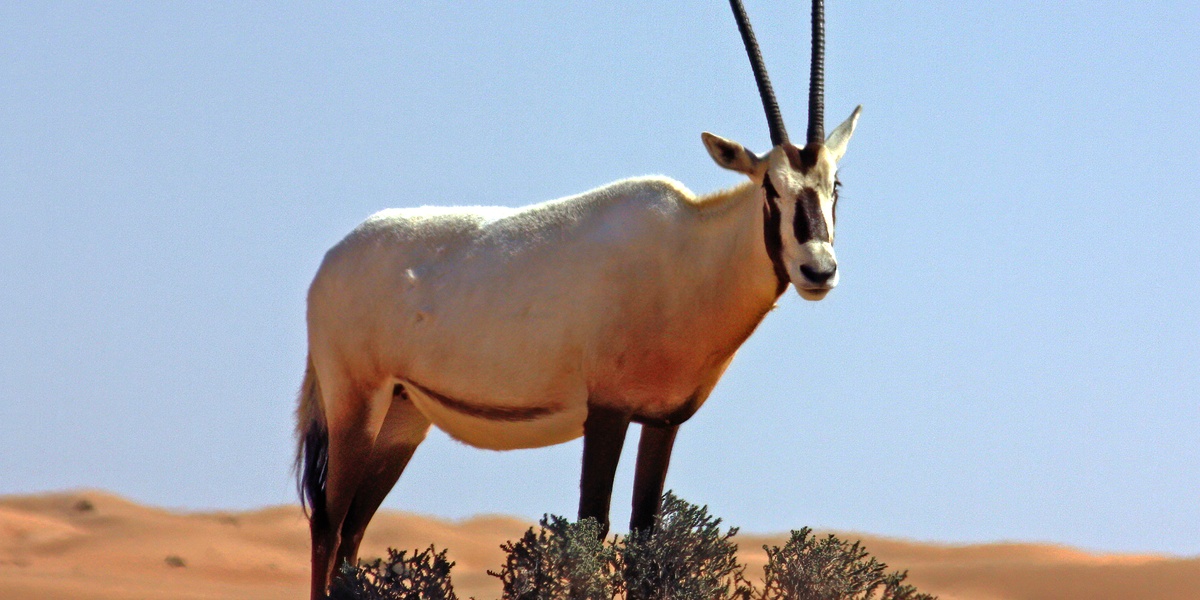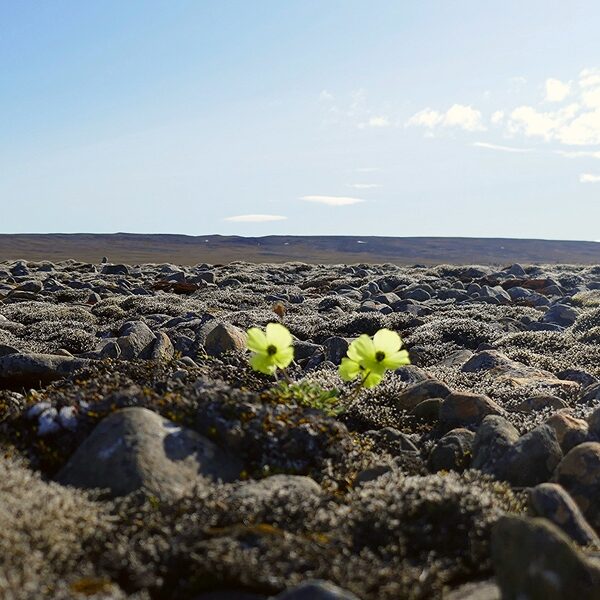Saudi Arabia’s landscapes—from Red Sea shores and coastal plains to mountain ranges and vast deserts—host a surprising variety of mammals adapted to heat, aridity, and rugged terrain. Field surveys, historical records, and conservation assessments together reveal how species survive in different pockets across the kingdom.
There are 52 Mammals of Saudi Arabia, ranging from the African wildcat to Sundevall’s jird. For each entry you’ll find below Scientific name,IUCN status,Habitat/Region (max 15 words), organized to make comparisons and conservation priorities easy to scan—you’ll find below.
Which species on the list need the most urgent conservation attention in Saudi Arabia?
Look first at the IUCN status column: species listed as Vulnerable, Endangered, or Critically Endangered face the highest immediate risks, often from habitat loss, hunting, or water scarcity; localised endemics and larger carnivores tend to be most at risk, so check the status and habitat notes in the table below for specifics.
How frequently is this list updated and where does the data come from?
The list synthesizes IUCN assessments, recent field studies, museum records, and national surveys; IUCN status reflects international evaluations but local surveys may update range and threats more often, so consult the table’s IUCN/status and habitat fields and look for the latest references cited below.
Mammals of Saudi Arabia
| Name | Scientific name | IUCN status | Habitat/Region (max 15 words) |
|---|---|---|---|
| Leopard | Panthera pardus | Critically Endangered | Mountain wadis, Asir, Al Baha |
| Caracal | Caracal caracal | Least Concern | Rocky hills, wadis; Hejaz, Asir, interior |
| Sandcat | Felis margarita | Least Concern | Sand deserts, Rub’ al Khali, interior deserts |
| African wildcat | Felis lybica | Least Concern | Oases, scrub, Red Sea coast, Hejaz |
| Striped hyena | Hyaena hyaena | Near Threatened | Arid scrub, wadis, mountains; Hejaz, interior |
| Golden jackal | Canis aureus | Least Concern | Coastal plains, agricultural land, Hejaz, eastern provinces |
| Rüppell’s fox | Vulpes rueppellii | Least Concern | Sandy & stony deserts, interior, Rub’ al Khali margins |
| Blanford’s fox | Vulpes cana | Least Concern | Rocky cliffs, wadis; Hejaz, Asir mountains |
| Red fox | Vulpes vulpes | Least Concern | Highlands, agricultural areas, NW and Hejaz |
| Fennec | Vulpes zerda | Least Concern | Sandy deserts and dunes, northern & central deserts |
| Honey badger | Mellivora capensis | Least Concern | Rocky & arid terrain, Hejaz and interior deserts |
| Arabian leopard | Panthera pardus | Critically Endangered | Mountain wadis, Asir and Al Baha |
| Arabian oryx | Oryx leucoryx | Vulnerable | Desert plains, protected reserves; central & western Saudi |
| Dromedary | Camelus dromedarius | Domesticated/Not Evaluated | Deserts, nomadic ranges; widespread feral herds |
| Nubian ibex | Capra nubiana | Vulnerable | Mountain cliffs and escarpments; Hejaz, Asir |
| Arabian sand gazelle | Gazella marica | Vulnerable | Sandy plains and sabkhas; eastern deserts, Gulf coast |
| Goitered gazelle | Gazella subgutturosa | Vulnerable | Open deserts and steppes; northern & interior deserts |
| Long-eared hedgehog | Hemiechinus auritus | Least Concern | Deserts, semi-arid plains; widespread interior |
| Desert hedgehog | Paraechinus aethiopicus | Least Concern | Sandy and rocky deserts; interior and western regions |
| House mouse | Mus musculus | Least Concern | Urban, agricultural areas, ports; widespread |
| Black rat | Rattus rattus | Least Concern | Ports, urban areas, coasts; widespread |
| Brown rat | Rattus norvegicus | Least Concern | Urban, agricultural, ports; widespread |
| Sand rat | Psammomys obesus | Least Concern | Saltbush flats, sandy plains; western & central deserts |
| Lesser Egyptian jerboa | Jaculus jaculus | Least Concern | Sandy dunes, Rub’ al Khali and deserts |
| Lesser mouse-tailed bat | Rhinopoma hardwickii | Least Concern | Caves, old buildings, desert fringes; widespread |
| Greater mouse-tailed bat | Rhinopoma microphyllum | Least Concern | Caves, wadis, Red Sea coast |
| Egyptian fruit bat | Rousettus aegyptiacus | Least Concern | Coastal caves, gardens; Red Sea coast, Hejaz |
| Egyptian free-tailed bat | Tadarida aegyptiaca | Least Concern | Caves, buildings, coastal cliffs; widespread |
| Kuhl’s pipistrelle | Pipistrellus kuhlii | Least Concern | Urban areas, scrub, coastal and inland |
| Schreiber’s long-fingered bat | Miniopterus schreibersii | Near Threatened | Coastal caves, sea-facing cliffs; Red Sea coast |
| Sperm whale | Physeter macrocephalus | Vulnerable | Deep waters, Red Sea & Arabian Gulf |
| Bottlenose dolphin | Tursiops truncatus | Least Concern | Coastal waters, Red Sea coast and Arabian Gulf |
| Spinner dolphin | Stenella longirostris | Least Concern | Offshore and coastal waters, Red Sea & Gulf |
| Dugong | Dugong dugon | Vulnerable | Shallow seagrass beds, Red Sea & Arabian Gulf coasts |
| Mediterranean monk seal | Monachus monachus | Critically Endangered | Sea caves and headlands; rare Red Sea coastline |
| Gerbil (Balochistan) | Gerbillus nanus | Least Concern | Sandy and stony deserts, interior |
| Sundevall’s jird | Meriones crassus | Least Concern | Desert plains and wadis; widespread interior |
| Arabian spiny mouse | Acomys dimidiatus | Least Concern | Rocky slopes, wadis, oases; Hejaz and Asir |
| Arabian shrew | Crocidura arabica | Least Concern | Wadis, mountain slopes, Hejaz and Asir |
| Cape hare | Lepus capensis | Least Concern | Desert plains, open scrub; widespread interior |
| Indian crested porcupine | Hystrix indica | Least Concern | Rocky hills, oases and terraces; Hejaz and Asir |
| Common genet | Genetta genetta | Least Concern | Wooded wadis, mountain scrub; Asir and Hejaz |
| Striped hyena | Hyaena hyaena | Near Threatened | Arid scrub, wadis, mountains; Hejaz, interior |
| Marbled polecat | Vormela peregusna | Vulnerable | Semi-arid scrub and steppe; northern interiors (rare) |
| Desert hedgehog | Paraechinus aethiopicus | Least Concern | Sandy and rocky deserts; interior and western regions |
| Brown long-eared bat | Plecotus auritus | Least Concern | Wadis and oak groves; highland Hejaz (local) |
| Bottlenose dolphin (Indo-Pacific) | Tursiops aduncus | Least Concern | Coastal, shallow waters; Red Sea and Gulf shallow bays |
| Striped dolphin | Stenella coeruleoalba | Least Concern | Offshore waters, Red Sea & Arabian Gulf |
| Rüppell’s fox | Vulpes rueppellii | Least Concern | Sandy & stony deserts, interior, Rub’ al Khali margins |
| Blanford’s fox | Vulpes cana | Least Concern | Rocky cliffs, wadis; Hejaz, Asir mountains |
| Balochistan gerbil | Gerbillus nanus | Least Concern | Sandy and stony deserts, interior |
| Saharan striped hyena? (duplicate excluded) | — | — | — |
Images and Descriptions
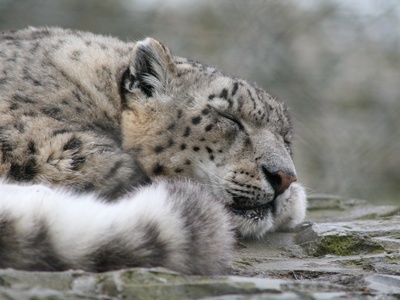
Leopard
A rare, medium-large spotted big cat. Now restricted to remote Asir and Al Baha mountains; solitary, elusive, about 30–90 kg, critically endangered locally and globally, surviving in rugged wadis and protected areas with intense conservation attention.
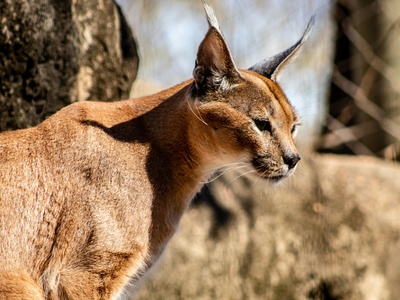
Caracal
A sleek, ear-tufted medium cat about 8–18 kg. Solitary and crepuscular, skilled at leaping for birds; occurs in wadis and rocky terrain of Hejaz, Asir and some interior regions, commonly photographed on camera traps.

Sandcat
A small desert specialist with pale fur and compact build, about 1–3 kg. Nocturnal and elusive, perfectly adapted to dunes; recorded in Rub’ al Khali and sandy plains, prized by wildlife enthusiasts for its secretive desert lifestyle.

African wildcat
A small, stripey, ancestral domestic-cat relative, about 3–6 kg. Solitary and secretive, lives near human settlements, oases and scrubby wadis; common ancestor of house cats and still widespread in coastal and interior scrublands.
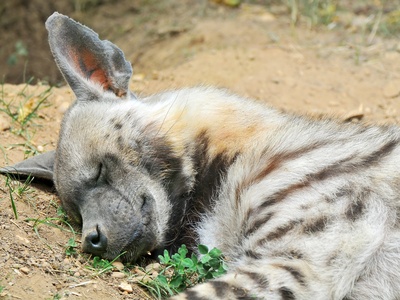
Striped hyena
A large, bone-cracking scavenger with distinctive stripes and mane, 20–55 kg. Nocturnal and shy, occupies arid and mountainous areas; uncommon but widely distributed across interior and western regions.
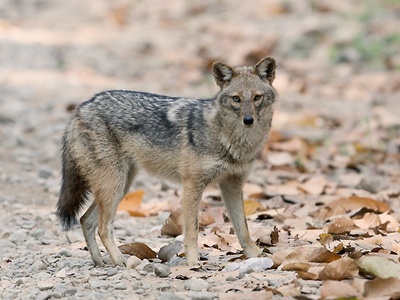
Golden jackal
A small canid about 6–12 kg, adaptable and omnivorous. Often found near farms and coasts, opportunistic feeder and sometimes forms small family groups; widespread across Saudi lowlands and coastal areas.
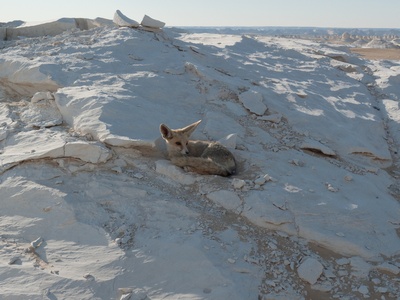
Rüppell’s fox
A small fox with large ears and pale coat, about 1–3 kg. Nocturnal desert specialist, digs burrows and feeds on insects, rodents and plants; common in sandy and gravel deserts.
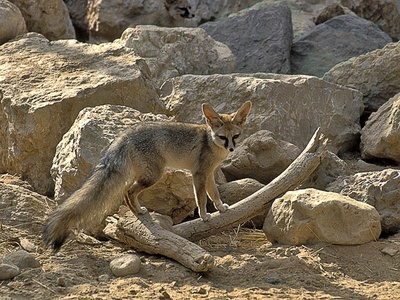
Blanford’s fox
A small, long-tailed fox adapted to cliffs, about 1–2.5 kg. Crepuscular with exceptional climbing ability; found in rocky mountain wadis and caves in western highlands.
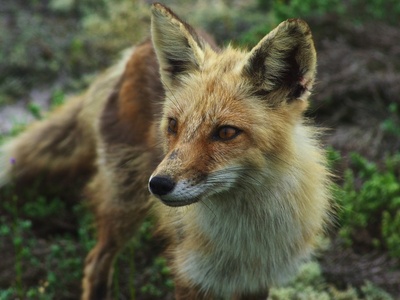
Red fox
A familiar medium-sized fox about 4–14 kg. Opportunistic omnivore found in higher elevations and farmlands; locally common in northern and western highlands.
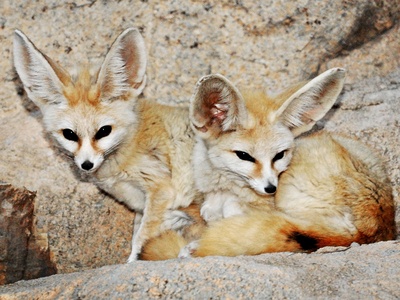
Fennec
Tiny iconic fox with massive ears, 0.5–2 kg. Nocturnal and adapted to extreme heat; lives in sandy desert dunes and is notable for large ears that dissipate heat and aid hearing.
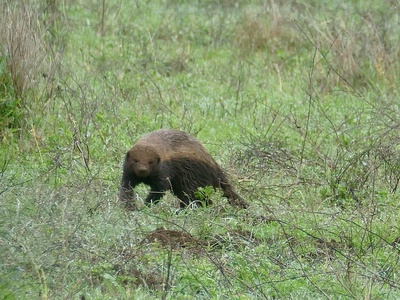
Honey badger
A tenacious, stout carnivore about 7–16 kg known for fierce defense. Solitary and omnivorous, digs for prey and occupies rocky areas and desert plains across Saudi Arabia.
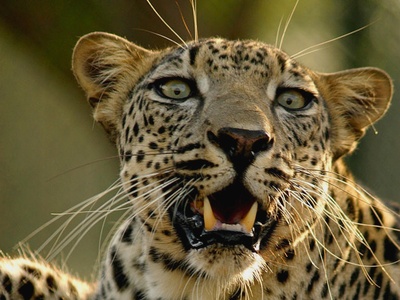
Arabian leopard
(See “Leopard” entry — included above)
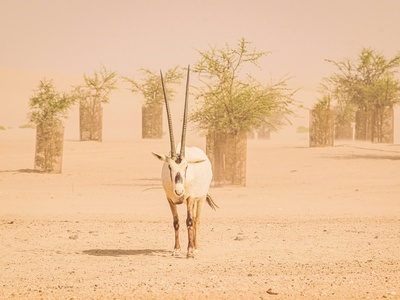
Arabian oryx
A striking white antelope with long, straight horns, 60–80 kg. Extinct in wild historically but successfully reintroduced in reserves; now visible in protected desert areas and rewilding projects.

Dromedary
The familiar one-humped camel, 400–700 kg. Domesticated but with feral populations across Saudi deserts; important culturally and ecologically, able to travel long distances and survive extreme aridity.

Nubian ibex
Agile wild goat with backward-curving horns, males 60–100 kg. Lives on steep cliffs and wadis; much sought after by photographers and threatened by hunting and habitat loss.

Arabian sand gazelle
A graceful desert gazelle, 15–35 kg, pale coat and curved horns. Lives in sandy lowlands and coastal deserts; populations fragmented and subject to conservation management.
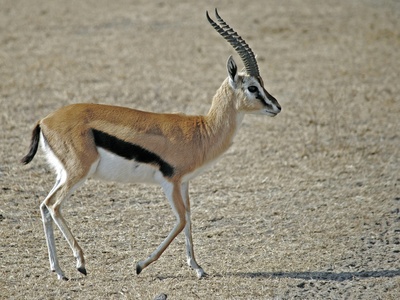
Goitered gazelle
A medium-sized gazelle about 20–40 kg, adapted to open arid plains. Shy and fast, historically widespread but now patchy due to hunting and habitat change.
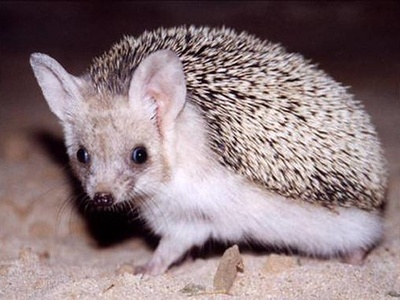
Long-eared hedgehog
A small nocturnal insectivore about 80–400 g with long ears. Eats insects and small vertebrates; common across sandy and stony deserts.

Desert hedgehog
A round, spiny insectivore about 150–500 g. Nocturnal and tolerant of arid conditions, found across much of Saudi Arabia’s deserts.
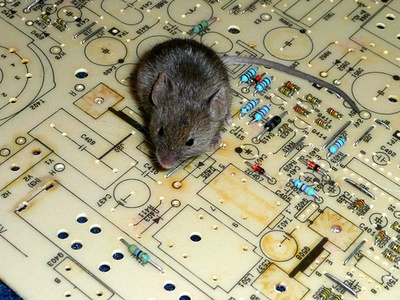
House mouse
Tiny commensal rodent 10–30 g, ubiquitous in human settlements. Highly adaptable and widespread in cities, farms and villages across Saudi Arabia.

Black rat
A medium-sized commensal rodent about 100–300 g. Climbs well and lives around human habitation, common in coastal towns and port cities.
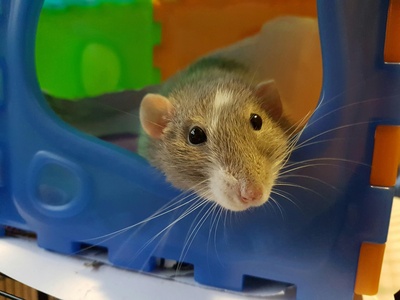
Brown rat
A stout commensal rodent 200–500 g. Lives in sewers, farms and buildings; introduced and now common in towns across the country.

Sand rat
A chunky desert rodent 80–200 g that feeds on halophyte plants. Lives in burrows in salt-flat and sandy habitats, important prey for desert predators.
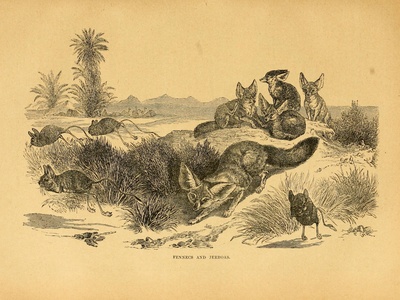
Lesser Egyptian jerboa
A small hopping rodent with long hind legs, 30–120 g. Nocturnal and adapted to dunes, it bounces across sand and is a classic desert specialist.

Lesser mouse-tailed bat
A distinctive bat with long tail and insectivorous diet, 12–30 g. Roosts in caves and ruins; common in arid lowlands and rocky areas.

Greater mouse-tailed bat
A large mouse-tailed bat 15–35 g. Nocturnal insect-eater that forms colonies in caves and cliff overhangs across western and central regions.

Egyptian fruit bat
A medium-sized fruit bat 80–200 g, roosting in caves and feeding on fruit and flowers. Common in coastal groves and cave systems.

Egyptian free-tailed bat
A fast-flying insectivorous bat with narrow wings, 10–25 g. Roosts in cliffs and buildings; widespread from coasts to interior deserts.

Kuhl’s pipistrelle
A tiny common pipistrelle bat 4–8 g. Tolerant of human areas, often seen around streetlights feeding on insects in towns and oases.
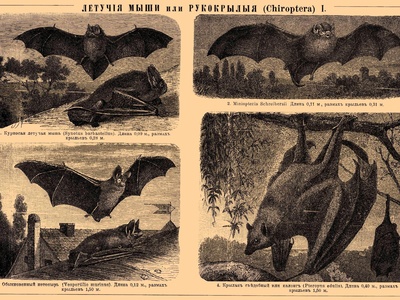
Schreiber’s long-fingered bat
A medium bat that forms large colonies in caves. Catches insects over water and cliffs; vulnerable due to roost disturbance but present in Red Sea cave systems.
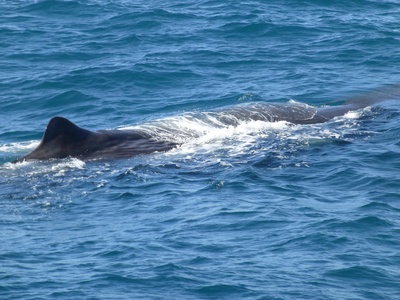
Sperm whale
A massive toothed whale up to 45,000 kg. Deep-diving predator of squid, occasionally reported in Red Sea and offshore Gulf waters; rare but known to local fishers.

Bottlenose dolphin
A common, robust dolphin 150–650 kg. Social and often seen from shoreboats, occupying bays, reefs and coastal waters along both Red Sea and Gulf coasts.
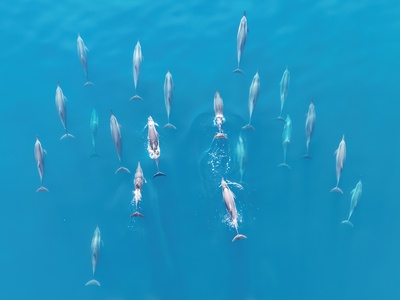
Spinner dolphin
A slim, acrobatic dolphin 50–80 kg noted for spinning leaps. Found offshore and around islands; occasionally seen from tours in Red Sea waters.
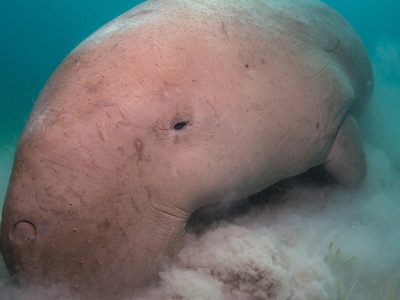
Dugong
A gentle, plant-eating marine mammal 200–400 kg that grazes seagrass flats. Vulnerable and locally important; sightings occur in sheltered coastal waters and lagoons.

Mediterranean monk seal
One of the world’s rarest seals, solitary and cave-dependent. Extremely rare in Saudi waters with occasional reports along remote Red Sea coasts.

Gerbil (Balochistan)
A small gerbil 15–40 g adapted to arid sandy and stony environments. Nocturnal and common in many desert localities across Saudi Arabia.
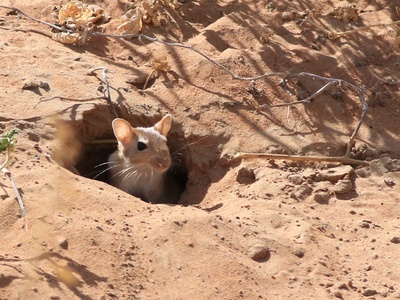
Sundevall’s jird
A robust gerbil-like rodent 50–150 g. Lives in burrow systems of sandy and rocky deserts and serves as key prey for nocturnal predators.
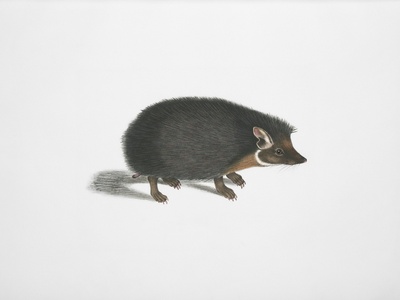
Arabian spiny mouse
A small, prickly-furred mouse 30–80 g. Diurnal to crepuscular, often near rocks and human settlements in western mountains and wadis.

Arabian shrew
A tiny insectivorous shrew 4–10 g. Secretive and fast-moving, found in moist microhabitats in mountainous western regions where leaf litter and springs occur.

Cape hare
A large rabbit-like hare 2–5 kg. Fast and crepuscular, inhabits open deserts and steppe, commonly encountered across Saudi Arabia’s lowlands and desert margins.

Indian crested porcupine
A large, nocturnal rodent up to 18–27 kg with quills for defense. Feeds on roots and crops, found in rocky and agricultural habitats in western highlands.
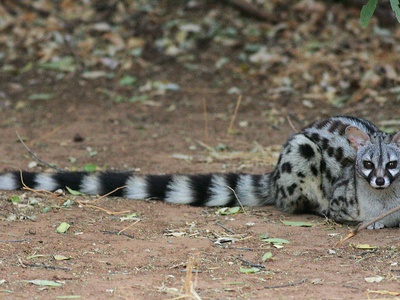
Common genet
A slender, spotted small carnivore about 1–3 kg. Nocturnal and arboreal, hunting small mammals and birds in scrubby wadis and oases of the southwest.

Striped hyena
(See earlier “Striped hyena” entry — included above)
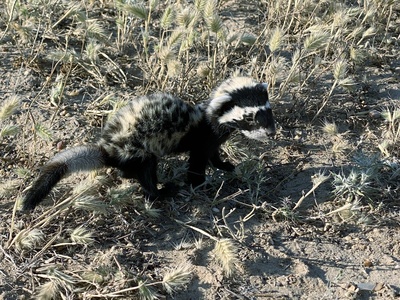
Marbled polecat
A small, colorful mustelid 0.6–1.2 kg. Secretive and declining; recorded rarely in open dry plains and steppe regions of northern Saudi Arabia.

Desert hedgehog
(See earlier “Desert hedgehog” entry — included above)

Brown long-eared bat
A forest-edge bat with large ears. In Saudi Arabia it is local in cooler highland groves and wadis, roosting in tree cavities and buildings.

Bottlenose dolphin (Indo-Pacific)
A slightly smaller coastal bottlenose form common in warm shallow seas. Social and often seen near reefs and inlets along Saudi Arabia’s coasts.

Striped dolphin
A streamlined, pelagic dolphin often seen offshore. Fast-swimming and social, occasionally seen during boat trips in deeper Red Sea and Gulf waters.

Rüppell’s fox
(See earlier “Rüppell’s fox” entry — included above)

Blanford’s fox
(See earlier “Blanford’s fox” entry — included above)

Balochistan gerbil
(See earlier “Gerbil (Balochistan)” entry — included above)
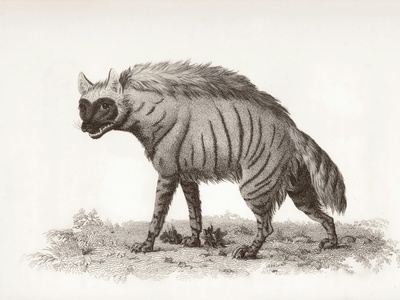
Saharan striped hyena? (duplicate excluded)
—
